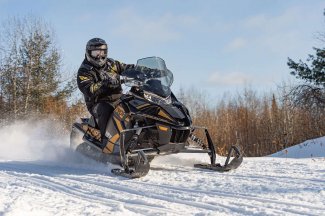With layers of fresh powder continuing to fall, lots of people have already taken their snowmobiles out on the trails to take advantage of these cold months. If you’re one of those people, we have a special message for you that you’ve probably already heard a thousand times, but it’s worth repeating just once more: always prioritize safety. As serene as the snow trails may seem, it’s very easy to find yourself in an emergency situation, ranging from annoying and frustrating to scary and dangerous. The best way to keep yourself safe and moving along the trail is proper preparation, both in gear and in knowledge. There are a few basics we here at Gordon Bay Marine think everyone should know before they get invested in a trail, so make sure you’re up to date on best safety practices. You’ll also want to make sure your sled is in good working condition so you don’t have a breakdown on the trail. When it’s time for a maintenance check, or if you need a repair, stop by our location in Lake Joseph, Ontario, near Muskoka and Toronto.
Clothing and Equipment
Start by making sure you’re wearing all the right gear. You’ll definitely want to stay warm and the best way to do this is to layer your clothing, rather than wearing one, heavily insulated layer. Overheating can cause you to sweat, which will then evaporate and potentially cause hypothermia. We suggest long underclothing, a long sleeve shirt, and then a vest at the very least in order to get the right amount of adjustable insulation. Your outermost layers will need to be waterproof, but they won’t need to be very thick unless it’s particularly cold out.
After you’ve covered your bases to stay warm, you’ll want to make sure you’re properly protected in the event of an accident. The snow may look nice and soft, but there’s no telling what kind of debris is lying just beneath the surface. You’ll want to make sure you’re wearing a helmet that covers the majority of your face in order to keep you safe from spills and from low hanging debris. If your helmet doesn’t already come with a face shield, you’ll want to get some goggles to ensure your eyes are well protected. Consider looking for a pair that comes with UV ray protection and anti-fog coating to make your ride easier.
Finally, you’ll want to bring along some basic tools and small replacement parts in the event you do have a breakdown and need a way to get to the nearest mechanic. This will probably include a basic toolkit, some replacement parts (if you can fit them), and a winch. Bonus tip, bring plenty of water to keep you hydrated.
Be Smart
There are a lot of little tips to stay safe while riding on the trails, but they essentially boil down to being smart about how you ride. Check the forecast before you head out so you can avoid whiteouts and other dangerous conditions. Let someone back home know where you’ll be and what time you expect to return, whether this is a friend, family member, or park ranger. Never ride if you think your focus is compromised, whether it’s through substances like drugs and alcohol, or general health concerns like illness, fatigue, or hunger. If you’re not sure if something is safe or if you should ride on a given day, be cautious and conservative with your choices.
Watch the Ice
Ice can be dangerous and unpredictable, but sometimes it’s unavoidable. Ice is safer on an established trail, as it generally means it’s thick enough to hold up other riders as well. Just keep in mind that ice, on any given body of water, will be thicker on the edges than in the middle, so stick to the outermost parts of these areas. However, if the temperature has been warming up and there’s a risk the ice has been melting, don’t risk going through these areas, even if you have to do some serious backtracking to go around.
Ice Breakthroughs
While we hope you never have to use this information, it’s better to know what to do in the event of a breakthrough than to try to go on instinct. Your first task will be to focus and try to avoid panicking. Abandon your snowmobile, no matter how valuable it may be, and start kicking toward the edge of the ice shelf. Plant both hands on the edge and carefully pull yourself up one leg at a time. However, don’t stand up once you’re out of the water. Placing too much pressure in a small area could risk another breakthrough. Instead, roll away to thicker ice or even solid ground. Once you’re safe, remove your wet clothing, perform calisthenics to warm up your body (push-ups, squats, jumping jacks, etc.), and make a fire as soon as you can. The last thing you’ll want to do is sit in cold, wet clothes.
As we said before, it’s better to be prepared for anything than to be surprised by an emergency and not know what to do. Hopefully, by having this knowledge, you’ll be able to have a fun, exciting ride every time you go out on your sled. If you’re still looking for the perfect snowmobile, stop by Gordon Bay Marine in Lake Joseph, Ontario to browse our in-stock models. We welcome all patrons from the areas of Muskoka and Toronto, Ontario.
